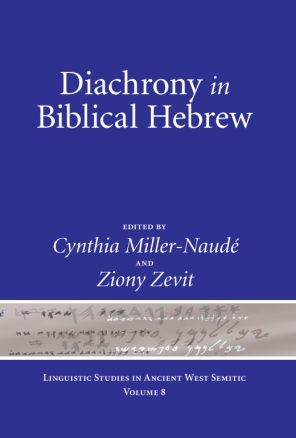Diachrony in Biblical Hebrew
Edited by Cynthia Miller-Naudé and Ziony Zevit
Diachrony in Biblical Hebrew is an indispensable publication for biblical scholars, whose interpretations of scriptures must engage the dates when texts were first composed and recorded, and for scholars of language, who will want to read these essays for the latest perspectives on the historical development of Biblical Hebrew. For Hebraists and linguists interested in the historical development of the Hebrew language, it is an essential collection of studies that address the language’s development during the Iron Age (in its various subdivisions), the Neo-Babylonian and Persian periods, and the Early Hellenistic period. Written for both “text people” and “language people,” this is the first book to address established Historical Linguistics theory as it applies to the study of Hebrew and to focus on the methodologies most appropriate for Biblical Hebrew and Aramaic. The book provides exemplary case studies of orthography, lexicography, morphology, syntax, language contact, dialectology, and sociolinguistics and, because of its depth of coverage, has broad implications for the linguistic dating of Biblical texts. The presentations are rounded out by useful summary histories of linguistic diachrony in Aramaic, Ugaritic, and Akkadian, the three languages related to and considered most crucial for Biblical research.
- Description
- Table of Contents
Preface
Abbreviations
Part 1: Introduction
Diachrony in Biblical Hebrew: Linguistic Perspectives on Change and Variation Cynthia L. Miller-Naudé
Part 2: Theoretical and Methodological Perspectives on Diachrony
Methodological Issues in the Dating of Linguistic Forms: Considerations from the Perspective of Contemporary Linguistic Theory B. Elan Dresher
Biblical Hebrew as a Diachronic Continuum T. Givón
Diachrony in Biblical Hebrew and a Theory of Language Change and Diffusion Jacobus A. Naudé
Detecting Development in Biblical Hebrew Using Diachronic Typology John A. Cook
Historical Linguistics and Biblical Hebrew Robert D. Holmstedt
Part 3: Examining Diachrony in Biblical Hebrew
Orthographic Features
Dwelling on Spelling A. Dean Forbes and Francis I. Andersen
Morphological Features
The Third-Person Masculine Plural Suffixed Pronoun -mw and Its Implications for the Dating of Biblical Hebrew Poetry Yigal Bloch
The Kethiv/Qere ה.וא, Diachrony, and Dialectology Steven E. Fassberg
Discerning Diachronic Change in the Biblical Hebrew Verbal System Martin Ehrensvärd
The Archaic System of Verbal Tenses in “Archaic” Biblical Poetry Tania Notarius
Syntactic Features
Diachronic Syntactic Studies in Hebrew Pronominal Reciprocal Constructions Elitzur A. Bar-Asher Siegal
Syntactic Aramaisms as a Tool for the Internal Chronology of Biblical Hebrew Naʿama Pat-El
Lexical Features
The “Linguistic Dating of Biblical Texts”: Comments on Methodological Guidelines and Philological Procedures Avi Hurvitz
The Evolution of Literary Hebrew in Biblical Times: The Evidence of Pseudo-classicisms Jan Joosten
Signs of Late Biblical Hebrew in Isaiah 40–66 Shalom M. Paul
Sociological and Dialectal Considerations
Language Variation, Discourse Typology, and the Sociocultural Background of Biblical Narrative Frank H. Polak
Northern Hebrew through Time: From the Song of Deborah to the Mishnah Gary A. Rendsburg
Text-Critical Considerations
Diachrony in Biblical Hebrew Lexicography and Its Ramifications for Textual Analysis Chaim Cohen
Part 4: Comparative Semitic Perspectives on Diachrony
Outline of Aramaic Diachrony Michael Sokoloff
Diachrony in Ugaritic Joseph Lam and Dennis Pardee
Diachrony in Akkadian and the Dating of Literary Texts N. J. C. Kouwenberg
Part 5: Afterword
Not-So-Random Thoughts Concerning Linguistic Dating and Diachrony in Biblical Hebrew Ziony Zevit
Indexes
Index of Authors
Index of Ancient Sources
Index of Scripture
Index of Hebrew Words
Index of Subjects
Also of Interest
Mailing List
Subscribe to our mailing list and be notified about new titles, journals and catalogs.






